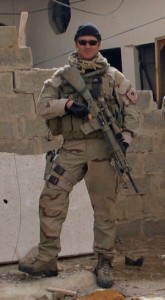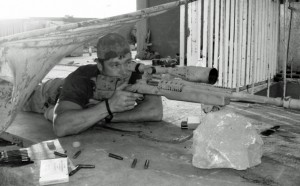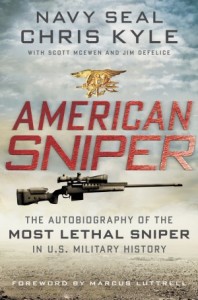By Charles W. Sasser

Three things you must know about Navy SEAL Chris Kyle: he’s a family man; he’s a Christian; and, third, he’s capable of snuffing out your lights at 2,000 yards if you pose a threat to American warriors under his protection.
So feared was he by Islamic terrorists and insurgents that they christened him al-Shaitan, “the Devil,” and placed a bounty on his head. He was known to other combat soldiers as The Legend.
A cowboy from north-central Texas, who worked ranches and became a professional rodeo saddle bronc rider, he was born and reared in the outdoors hunting and fishing, where he inculcated the traditional values of his rugged frontier ancestry—honor, courage, self-reliance, patriotism. . . From 2003 to 2009, through four combat tours in Iraq, he recorded the most confirmed sniper kills in United States history.
In a wide-ranging conversation with Command Posts, Kyle talked about his military career, his family, his faith, his patriotism and about the art and science of shooting as a sniper in combat. Like many such men in the warrior profession, especially those in Special Operations units like SEALs, Rangers and Army Special Forces (Green Berets), Kyle is soft-spoken, humble, and straight-shooting. If you don’t want to know the truth about something, don’t ask him.
“I’m no hero,” he maintained. “The reason I agreed to write American Sniper (his autobiography, written with Scott McEwen and Jim DeFelice) is to raise awareness for our guys in combat, to show the hardships they face and the sacrifices they and their families make. The real heroes are guys like Ryan Job and Marc Lee who gave everything for their country.”
Job and Lee were fellow SEALs and Kyle’s close friends. Lee died almost immediately of an enemy bullet while holding off an insurgent attack. Another bullet blinded Job in a separate battle. He survived, only to die several years later of complications from his wounds. Kyle was with both men when they were hit.
Kyle enlisted in the Navy in 1999 and went on through BUD/S training to become a SEAL. Certain types of men seem to gravitate toward high-risk outfits like Special Operations forces. Such men tend to be more individualistic, more self-assertive and confident.
“I think for the most part they are country boys who have grown up in the woods with weapons. I think it has to do with pride. I didn’t want to be part of a unit going out and doing nothing but following orders. I wanted to have a little more impact on the war. It also has to do with pride in unit. Whether you’re a Ranger, an SF (Special Forces) guy, a SEAL, there is a brother cohesion. You have another family.”

Kyle has always been a shooter, starting with his first Daisy air rifle when he was a kid. In the SEALs, he hung around the sniper platoons, learning everything he could about the “silent craft.” Eventually, his platoon chief recognized his abilities and nominated him for sniper school. The Navy now has its own school; previously, only the Army and Marines offered sniper training.
“It seemed like a natural for me. We’re out there for a purpose—to save American lives. We’re not out there looking for the credit.”
Carlos Hathcock from the Vietnam War has long been regarded as America’s most successful sniper. He recorded 93 confirmed kills; his actual number probably exceeded 300. In order for a “kill” to be confirmed, it must be witnessed. If an enemy soldier is shot through the stomach and crawls off somewhere to bleed out, he is not “confirmed.” Like Kyle, Hathcock was quiet-spoken, polite, and a Christian who did what he did to “save American lives.”
“The only reason people compare me to Carlos,” Kyle reasoned, “is because they don’t understand about sniping. Just because I hold the record for American snipers does not make me as good as Carlos. The actual killing is nothing. Carlos was out there in the jungle, by himself. There was that one instance where, camouflaged, alone, he stalked a VC general behind enemy lines to take him out. I still think he is the greatest sniper of all times, not just American.”
The Iraqi War kicked off on 20 March 2003 when Coalition Forces invaded the “land between the rivers,” the home of Adam and Eve. Kyle made his first kill as a SEAL sniper before the month ended.
U.S. Marines were flooding up the road through a small village near Nasiriya, marching to liberate the country from Saddam Hussein, when a young woman with a little boy stepped out of her house. Kyle and his sniper platoon were on the roofs of nearby buildings, having sneaked into position earlier as “overwatch” to protect Marines from ambush.

A squad of Marines got out of a vehicle to conduct a foot patrol. The young woman produced a Chinese grenade and pulled the pin, but held down the handle while she waited for the Americans to approach. She was obviously intent on a suicide attack against them. Kyle had no choice but to fire his .300 Winchester Magnum in order to save the Marines. It was the only time he ever killed anyone other than a male combatant.
“We tried to contact the Marines by radio to warn them, but we couldn’t raise them. Killing her affected me. I definitely hesitated. I didn’t want to take that shot. I didn’t. She was a woman with a child. But after I did it, I got pissed that she put me in a position to have to do it. Nobody should be asked to do that—but she forced it. It was clear she didn’t care about herself, her child, or anyone else that would have been blown up or killed in the firefight.”
During the next six years, Kyle and his deadly rifle (he used a variety of weapons, ranging from the military M4 to a .308 sniper rifle) left 160 “confirmed” bodies strewn in their wake in what was soon to be America’s longest war. The actual death toll from his sharpshooting probably exceeds 200. He refuses to discuss “body count.” His standard response to the question of numbers is: “Does the answer make me less, or more, of a man? Killing was necessary to save lives.”
Some contend that patience is a sniper’s most important skill. Kyle disagrees.
“I believe it is professional discipline. Professional discipline and powers of observation. The ‘right stuff’ is the ability to judge the environment, figure out when something doesn’t fit in, to put yourself in the enemy’s position and determine what he is trying to accomplish. And then to know when to do the right thing to help protect troops on the ground.”
The philosophy of using snipers in combat has changed and evolved over the decades. Previously regarded as “gunfighters” and “cold-blooded killers,” snipers have attained a respected and professional status in all branches of arms.
“Snipers have absolutely become more acceptable since Vietnam and Carlos Hathcock. The military now views snipers as a valuable asset, a force multiplier to overwatch the battlefield and help protect troops. There are always going to be snipers around somewhere as protective cover to help the fight.”

Close calls come with the territory. Kyle is well-decorated with medals for valor. Although he had never received a Purple Heart, he was shot twice during the same battle. His helmet deflected one bullet while a second bullet slammed into his back. It penetrated his body armor only enough to make a small scratch in the skin. Knocked down, dazed, he recovered and returned to the fight. He considers himself lucky, considering the number of firefights in which he was involved.
His greatest cultural shock occurred after redeployment stateside following his first combat rotation.
“It seemed extremely awkward that we’d gone overseas where people were dying while life here went on as usual. There were still traffic jams and the same things on radio and TV. All we got in Iraq was CNN, and it was all about Americans protesting the war. That wasn’t the true voice of Americans. I was a little discouraged at first. After being home, I saw how Americans honor and support our troops. That’s when I began to understand that they’re why we do what we do—so they can live their lives normally.”
Kyle met his future wife Taya in California between deployments. Her dad had been a Marine during the Vietnam War era and she had been raised to respect the military. However, she had had an unpleasant encounter with a self-centered and obnoxious distant relative who wanted to be a SEAL but could not measure up. Because the relative had wanted to be a SEAL for selfish reasons, she jumped to the initial conclusion that all SEALs must therefore be selfish and self-centered.
“She told me I must be selfish. I came back with how could I be selfish when I’m willing to go overseas and die for my country? She changed her mind and called me a ‘romantic’ because I romanticized duty and honor and patriotism. She thought I was romanticizing everything about war and our country. I’m a realist, but I love my country, the United States of America. No matter who is president, this is still the greatest nation in the world. I’m extremely proud of it. I will fight to keep it free and great.”
Kyle and Taya now have two children, a son, 7, and a daughter, 5. Taya refers to Kyle as one of the most genuine people she has ever known.
“Taya has always been extremely proud of me,” he said.
He thought a long moment when questioned about how he reconciled his Christian faith with killing.
“Plagues, violence and war are nothing unfamiliar to Christianity. God sent the Jews to war, to kill other people to right wrongs and to defend. The Commandment is against murder and the taking of innocent life, not against killing in war.”
One of his favorite verses out of the Bible is Romans 13:4: For he is the minister of God to thee for good. But if those do that which is evil, be afraid; for he beareth not the sword in vain; for he is the minister of God, a revenger to execute wrath upon him that doeth evil.
“If a man doesn’t stand up to evil, then evil will overcome and destroy.”
Chris Kyle left the SEALs in 2009, after nearly eleven years in the Navy, most of that time as a sniper. He now works for a company that offers very specific training for police and military. He is also active in supporting the Wounded Warrior Project created to help raise money and support for injured, wounded and handicapped veterans. He often appears with fellow SEAL Marcus Luttrell, author of Lone Survivor: The Eyewitness Account of Operation Redwing and the Lost Heroes of SEAL Team 10.
While the “Devil of Ramadi” may now be a family man in Texas, his legend nonetheless continues to grow. Chris Kyle is the American Sniper, a brave American, and a hero by any definition.

CHARLES W. SASSER is a decorated Vietnam veteran and Green Beret as well as one of the most respected military writers in the field. He is the author of more than fifty books, including None Left Behind: The 10th Mountain Division and the Triangle of Death; Predator: The Remote-Control Air War Over Iraq and Afghanistan, A Pilot’s Story; One Shot, One Kill; First SEAL; and Raider.
